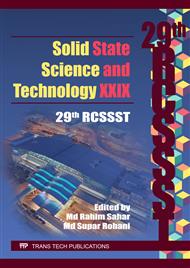[1]
R. De Almeida, D.M. Da Silva, L.R.P. Kassab, C.B. de Araujo, Eu3+ luminescence in tellurite glasses with gold nanoparticles, Opt. Com. 281 (2008) 108–112.
DOI: 10.1016/j.optcom.2007.08.072
Google Scholar
[2]
L.P. Naranjo, C.B. de Araújo, O.L. Malta, P.A. Santa Cruz, L.R.P. Kassab, Enhancement of Pr3+ luminescence in PbO-GeO2 glasses containing silver nanoparticles, Appl. Phys. Lett. 87 (2005) 241914-241918.
DOI: 10.1063/1.2143135
Google Scholar
[3]
C.D. Geddes, J.R. Lakowicz, Editorial: Metal-enhanced fluorescence, J. Fluoresc. 12 (2002) 121-129.
Google Scholar
[4]
K. Aslan, I. Gryczynski, J. Malicka, E. Matveeva, J.R. Lakowicz, C.D. Geddes, Metal-enhanced fluorescence: an emerging tool in biotechnology, Curr. Opin. Biotechnol. 16 (2005) 55–62.
DOI: 10.1016/j.copbio.2005.01.001
Google Scholar
[5]
A.V. Zayats, I.I. Smolyaninov, A.A. Maradudin, Nano-optics of surface plasmon polaritons, Phys. Rep. 408 (2005) 131314-131318.
DOI: 10.1016/j.physrep.2004.11.001
Google Scholar
[6]
Z.A.S. Mahraz, M.R. Sahar, S.K. Ghoshal, M.R. Dousti, Concentration dependent luminescence quenching of Er3+-doped zinc boro-tellurite glass, J. Lumin. 144 (2013) 139-145.
DOI: 10.1016/j.jlumin.2013.06.050
Google Scholar
[7]
Z.A.S. Mahraz, M.R. Sahar, S.K. Ghoshal, M.R. Dousti, R.J. Amjad, Silver nanoparticles enhanced luminescence of Er3+ ions in boro-tellurite glasses, Mater. Lett. 112 (2013) 136–138.
DOI: 10.1016/j.matlet.2013.08.131
Google Scholar
[8]
C.B. De Araujo, L.R.P. Kassab, R.A. Kobayashi, L.P. Naranjo, P.A. Santa Cruz, Luminescence enhancement of Pb2+ ions in TeO2-PbO-GeO2 glasses containing silver nanostructures, J. Appl. Phys. 99 (2006) 123522-123526.
DOI: 10.1063/1.2208288
Google Scholar
[9]
T. Hayakawa, S.T. Selvan, M. Nogami, Field enhancement effect of small Ag particles on the fluorescence from Eu3+ -doped SiO2 glass, Appl. Phys. Lett. 74 (1999)1513-1517.
DOI: 10.1063/1.123600
Google Scholar
[10]
P. Innocenzi, G. Brusatin, A. Martucci, K. Urabe. Thin Sol Film. 279 (1996) 23-27.
Google Scholar
[11]
L.R.P. Kassab, M.E. Camilo, C.T. Amâncio, D.M. da Silva, J.R. Martinelli. Opt. Mater. 33 (2011) 1948-(1952).
Google Scholar
[12]
J.A. Jimenez, Influence of Ag nanoparticles on the luminescence dynamics of Dy3+ ions in glass: the plasmonic diluent'effect, Phys. Chem. 15 (2013) 17587-17591.
DOI: 10.1039/c3cp52702f
Google Scholar
[13]
M. Mattarelli, M. Montagna, K. Vishnubhatla, A. Chiasera, M. Ferrari, G.C. Righini, Mechanisms of Ag to Er energy transfer in silicate glasses: a photoluminescence study, Phys. Rev. B. 75 (2007) 125102-125106.
DOI: 10.1103/physrevb.75.125102
Google Scholar
[14]
S.K. Singh, N.K. Giri, D.K. Rai, S.B. Rai, Enhanced upconversion emission in Er3+-doped tellurite glass containing silver nanoparticles, Sol. State. Sci. 12 (2010)1480-1483.
DOI: 10.1016/j.solidstatesciences.2010.06.011
Google Scholar


